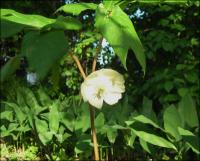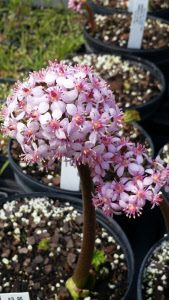…Honeysuckle Magnolia – all Monarda –all – Beebalm Oenothera –all – Sundrops/Primrose Alcea rosea Onoclea sensibilis Sensitive fern Osmunda cinnamomea Cinnamon fern Phlox – all Physotegia virginiana Obedient plant Podophyllum…
More »Search Results for: Podophyllum peltatum
-
Podophyllum peltatum Mayapple, Hog apple, Mandrake Z 4-9
White waxy cups in spring. Ephemeral, dies back in summer....
White waxy cups in spring. Ephemeral, dies back in summer.
Size: 18" x 4' spreading by rhizomes
Care: moist well-drained soil in full to part shade.
Native: Quebec to Minnesota, south to Florida & Texas, Wisconsin nativeNamed for its supposed resemblance to a duck’s foot (Anapodophyllum.) Mayapple root used medicinally by Native Americans – for the Iroquois & Delaware as a laxative and purgative, to purify the body and expel worms. Cherokee and Menomonee made the root’s juice to protect corn and potatoes from insects. Oneidas made a poltice for sores – cut every joint of root & bake half a day until brown then add water. Roots also used by Native Americans and early settlers as a purgative, emetic, “liver cleanser,” worm expellant, and to remedy jaundice, constipation, hepatitis, fevers and syphilis. Introduced 1664. You can hunt Morel mushrooms when Mayapples bloom.
Common Names of Plants
…caespitosum Mayapple Podophyllum peltatum Meadow anemone Anemone canadensis Meadow cranesbill Geranium pratense Meadowrue Thalictrum aquilegifolium Meadowrue Thalictrum ichangense Meadowrue Thalictrum rochebruneanum Meadow sage Salvia nemorosa Meadowsweet Spiraea alba Melic grass…
More »-
Darmera peltatum syn. Peltiphyllum peltatum Umbrella plant, Indian rhubarb Z 5-8
Grow this for its pink umbellifer flowers in earliest spring or its gigantic, round ruffled edged green turning red foliage for drama.
Grow this for its pink umbellifer flowers in earliest spring or its gigantic, round ruffled edged green turning red foliage for drama.
Size: 3-4’ x 3’
Care: shade to part sun in moist well-drained to wet soil
Native: Oregon & California
Awards: Royal Horticultural Society Award of Garden MeritKarok natives (NW corner of California) ate young shoots and Miwok tribal members, (N central California), mixed crushed root with acorn meal to make it white. Collected before 1849 when its description first published.


